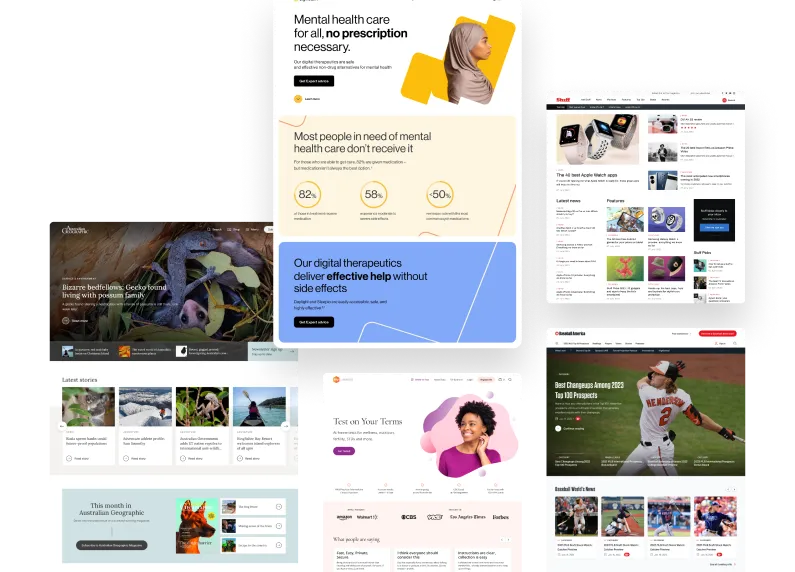For the better part of a decade, XWP has helped some of the world’s biggest publishers and media companies improve website performance and grow their businesses. How? While our projects take many forms, our roots are in migrations.
From our very first project working with News Corp Australia to migrate over 90 brands and 15 sites onto WordPress, to helping PMC build a robust foundation for Variety.com and RollingStone.com to thrive in their unique portfolio of brands, our team has gained the knowledge and expertise to become one of the most trusted teams to perform CMS migrations.
Throughout our years of experience, we’ve learned the ins and outs of migrations––how to keep sites running smoothly while migrations are taking place; how to ensure data, media, and content are all migrated without issue; and how to improve performance along the way––and we want to share our experience with you. What are some of the best practices for migrating publishers and media companies to WordPress? We’ve learned that it’s all about asking the right questions.
Why Are You Migrating?
Each different CMS provides unique benefits that give it an advantage over others. So why are you leaving your current CMS? Is it because of a lack of functionality? Cost? Or is your old CMS being sunsetted? Whatever the reason, and there are plenty, you want to be sure you’re making the right choice when searching for a new one.
You could also be sticking with the same CMS, and just moving to a new host. This type of migration poses its own set of challenges, but the same questions below still apply. Just replace ‘CMS’ with ‘host’ and you’ve got yourself a recipe for success.
Where Are You Migrating?
There are hundreds of CMSs out there to choose from: Drupal, Joomla, Sitecore… just to name a few. When it comes to publishers and media companies, we like to take a look at a few different options for migrations, but usually the best answer to the question “Where are you migrating?” in our opinion, is WordPress.
Why WordPress?
- A low cost of entry.
- Extremely customizable.
- Easy to use.
- Great hosting partners.
- Easy advertising.
- Find out more here.
But again, WordPress is a choice. It’s not the only choice. Each CMS is unique, just like each of our clients has a unique set of needs and challenges. We like to analyze each situation individually and ensure you’re making the right choice when moving. Sometimes another CMS is a better fit due to architecture or configuration reasons, and we occasionally recommend other options, too.
Once we figure out where you’re migrating, we dive into the how.
How Complex Is Your Migration Going to Be?
We like to break migrations down into three different categories.
Small Migrations
For a small or simple migration, you don’t have much to worry about. The size of your migration might allow you to use some off-the-shelf migration tools. You’ll of course want to monitor the site after the migration to ensure all content and functionality are working the way they need to, but these are relatively easy to achieve.
Medium Migrations
With a medium-sized migration, teams have a bit more to consider. Instead of just migrating and recreating a site, we might be doing a full on redesign. But what will that redesign entail? Can we reuse some assets, or will we be recreating everything involved?
Once you’ve got design work sorted out, it’s time to look at data. Data mapping is integral to a successful migration, and we want to ensure it’s done correctly. One of the most important questions is: how much data do you have to move? Some media sites can have years of data to migrate. When it came to Rolling Stone, there was over 20 years of data and 250,000+ assets to migrate. This required custom scripts and tools to work smoothly. Your migration might, too.
Large Migrations
We previously mentioned our work with Rolling Stone. Decades of content and data, 250,000+ assets and media files to move. This was definitely a large migration. The original RollingStone.com was built on a legacy PostgreSQL based platform. Their new parent company, PMC, uses WordPress as part of the foundation of their successful online media portfolio.
To migrate this massive site, our team developed a detailed rollout strategy to ensure success. This included data mapping by hand, thorough testing, and close collaboration with the Rolling Stone/PMC team.
What Else Are We Doing?
We’ve said it already: some migrations are simple, others are massively complex. But it’s not just the size of the migration that matters, it’s what exactly we’re doing with the site during the move, most notably, whether we’re performing a full redesign or just re-creating existing functionality.
A Re-Creation
A migration can be a great opportunity to ‘start over,’ but past decisions, both technical and business, were made for a reason. It’s important to fully understand the past of a site and business to see what the needs for a migration truly are. Sometimes, this discovery phase can show that a lot of the components and functionality play vital roles in a site.
A Full Redesign
Sometimes, if it’s what a client wants and if it’s what the project truly needs, we might need to perform a full site redesign along with a migration. In some ways, this makes things easier. Specific content and images might be pulled over, but a lot of the functionality can be left behind. On the other hand, it can make a migration that much more time consuming because a design team needs to be brought in to create an entirely new website.
With every migration comes opportunity. We like to take time during a migration to:
- Trim excess fat from code.
- Improve UX and performance.
- Improve editorial workflows.
- And more.
Want to learn more about our approach to migrations? Check out this episode of Tech XPress where we take a deep dive into how our team works.
Perhaps the best question we can ask from the very beginning is…
What Can Go Wrong?
As the old saying goes, ‘Be prepared,’ and that goes doubly so for a website migration. So many times we’ve heard of migrations going wrong because there was a rush to go live. Instead of rushing (and potentially messing up along the way), we anticipate and eliminate as many difficulties as possible in advance. Acknowledging those difficulties, however minor, and knowing that they still might occur during the migration process, ensures that our team is ready and prepared to resolve any issues that arise during launch.
Learn More About Our CMS Migration Services
Are you planning a move to WordPress in the near future? We’d love to help! Whether working with your team directly or just answering questions we want to help you make the move to WordPress as efficient and effective as possible. Contact us and let’s talk!
What have we learned about how to perform a website migration? Never stop asking questions. Our team is chock full of experts from around the world. They’ve performed hundreds of migrations between them, and they will never stop asking questions when it comes to your migration. Being prepared, knowing what challenges might be ahead, and anticipating how to solve them, are the best ways to avoid complications. Because let’s face it: the last thing you want when your site is being migrated to WordPress is a complication. Communication is the best way to avoid it.


